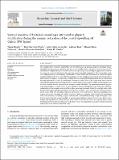Por favor, use este identificador para citar o enlazar a este item:
http://hdl.handle.net/10261/316270COMPARTIR / EXPORTAR:
 SHARE SHARE
 CORE
BASE CORE
BASE
|
|
| Visualizar otros formatos: MARC | Dublin Core | RDF | ORE | MODS | METS | DIDL | DATACITE | |

| Título: | Vertical zonation of bacterial assemblages attributed to physical stratification during the summer relaxation of the coastal upwelling off Galicia (NW Spain) |
Autor: | Montes, Tania; Guerrero-Feijóo, Elisa; Moreira-Coello, Víctor; Bode, Antonio CSIC ORCID CVN; Ruiz-Villarreal, Manuel CSIC ORCID ; Mouriño-Carballido, Beatriz; Varela, Marta María | Palabras clave: | Bacteria Medio Marino Centro Oceanográfico de A Coruña CARD-FISH 454.pyrosequencing Microplankton Summer upwelling relaxation Upwelling pulse NW Spain |
Fecha de publicación: | 30-oct-2020 | Citación: | Estuarine Coastal and Shelf Science, 245. 2020: 106791-106804 | Resumen: | We combined flow cytometry, CARD-FISH, and 16S rRNA gene tag pyrosequencing to investigate bacterioplankton dynamics along a transect in shelf waters off A Coruña (Galicia, NW Spain). Over five days (16-20th July 2012) we sampled during the relaxation of a summer upwelling pulse, providing an opportunity to examine the impact of pulses of cold nutrient-rich water into coastal microbial communities. The hydrographic conditions, characterized by intense density stratification of surface waters and the presence of a deep chlorophyll maximum (DCM) at 20–30 m, were relatively maintained over the sampling period. Indeed, bacterial abundance and composition displayed low day to day variation. Alpha diversity analysis suggested that species richness and diversity increased from coastal to shelf stations and from the surface down to the coastal DCM, which could be caused by the mixing of upwelled bacteria with the coastal surface waters. SAR11, SAR86, and Roseobacter were the most abundant bacteria detected in the samples by using CARD-FISH. The assemblages observed by pyrosequencing displayed a strong vertical zonation along the transect. Rhodobacteraceae (under class Alphaproteobacteria) and Bacteriodetes dominated the surface waters and decreased during the upwelling pulse, while SAR 86 (under class Gammaproteobacteria), Actinobacteria and SAR11 clade increased their relative abundance at the coastal DCM with upwelling relaxation, particularly at the shelf stations. Bacterial assemblages from surface waters were associated with higher temperature and light conditions, while coastal DCM assemblages were rather associated to salinity, inorganic nutrients and a diatom-bloom leading to high chlorophyll-a. Our findings suggest that the vertical variability in environmental conditions induced by the intense density stratification, the exportation of warmer and less saline surface water from the rias to the adjacent shelf, and the fertilizing effect of recently upwelled water at the deeper layer, determined the composition of distinct bacterial assemblages at the subsurface and DCM layers. | Descripción: | Research article | Versión del editor: | https://www.sciencedirect.com/science/article/pii/S0272771419304032 | URI: | http://hdl.handle.net/10261/316270 | DOI: | 10.1016/j.ecss.2020.106791 | ISSN: | 0272-7714 |
| Aparece en las colecciones: | (IEO) Artículos |
Ficheros en este ítem:
| Fichero | Descripción | Tamaño | Formato | |
|---|---|---|---|---|
| Vertical-zonation-of-bacterial-assemblages-attributed-to-_2020_Estuarine--Co.pdf | Artículo principal | 6,23 MB | Adobe PDF |  Visualizar/Abrir |
CORE Recommender
SCOPUSTM
Citations
4
checked on 18-may-2024
WEB OF SCIENCETM
Citations
4
checked on 17-feb-2024
Page view(s)
24
checked on 20-may-2024
Download(s)
16
checked on 20-may-2024
Google ScholarTM
Check
Altmetric
Altmetric
Este item está licenciado bajo una Licencia Creative Commons

